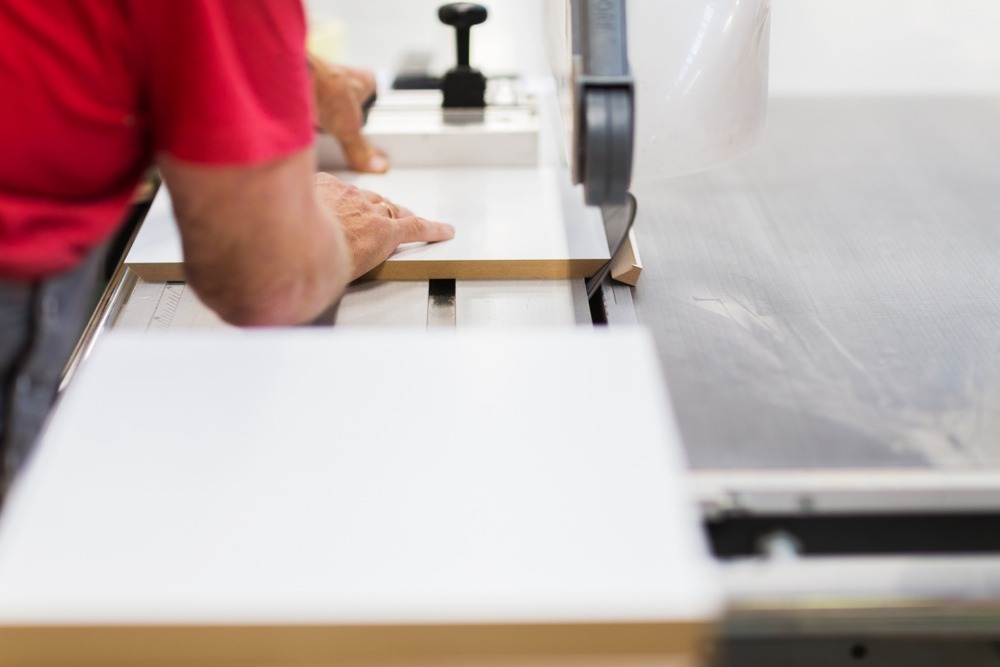MDF – three letters that cover a wide history and variety in the history of interior design. They stand for Medium Density Fibreboard, which is a rather dull-sounding term for a material that opened a world of possibilities for décor and furniture in the mid-20th century. And it still offers loads of neat and creative options for decorating and furnishing a space today.
How MDF is made
MDF is made by breaking down wood pulp into its individual fibers, which are then combined with resin and pressed into boards under high heat and pressure. The result is a smooth and strong material that can be made in a wide variety of sizes and thicknesses. The smooth finish and strength made it superior to traditional particleboard and plywood while being available at a lower cost than natural solid wood. It was quickly adopted for making cabinetry and other furniture.
MDF and fashion
The solidity and strength of MDF made it very adaptable. It can be machined and cut into complex shapes, while its smooth, consistent and grain-free surface is highly suitable for painting and other sorts of covering. These qualities led to its widespread adoption from the mid-1960s, being used for both the bright-painted, sleek and modernist styles associated with the 1960s and the blockier, earth-tone fashions of the 1970s.
For that decade wood panelling and other natural textures were back in fashion, and the qualities of MDF let it remain highly suitable as fashions changed. That hard, smooth surface was ideal for applying veneers, providing the appearance of natural wood with grain and knots but at a fraction of the cost.
Customised for any purpose
The 1970s saw a boom in do-it-yourself activities as people rediscovered the pleasures and advantages of building, adapting and repairing things around the home themselves – a boom that reappeared in the 1990s and then reached new heights in the 2020s. During the COVID-19 pandemic, many of us took on projects around the house, and that desire is still with us. With its consistent texture and strength, as well as its being produced in boards of standard size that can then be cut to size, MDF was the ideal option.
One of the classic uses for MDF around the home is for shelving. Its strength means it can support a lot of weight, while its dense texture provides a good anchor for screws, hooks and plugs for mounting. And it’s easily sized, cut and trimmed to any shape, even irregular ones – ideal for older houses where nooks and corners may not have any right angles.
The consistent nature of MDF makes it highly suitable for crafting into finely cut shapes. Both DIYers and professionals find it ideal for making things such as custom picture frames, storage boxes, and even wall art items. This customizability also suits MDF for repairing or rejuvenating existing pieces of furniture – worn or broken parts of chairs, sofas, or beds can be replaced with cut-to-measure MDF parts. Thanks to MDF’s suitability for painting and other coatings, it can just as readily be used for visible or prominent parts such as tabletops – a specially cut board of MDF can be the perfect way to replace a worn, scratched or stained tabletop.
New possibilities for MDF
Technology continues to bring new possibilities to MDF. Like all wood products, MDF can be grown and produced sustainably and, in many cases, makes use of wood left over from other processes that would otherwise go to waste. New developments have allowed the elimination of the traditional formaldehyde-based resins, and zero-formaldehyde MDF is now available.
More visible advances are offering new opportunities for creativity with MDF. Traditional MDF isn’t great in humid or damp environments, but new types are available with the core impregnated with moisture-resistant resin, allowing this wood to be used in kitchens and bathrooms. MDF can now be dyed in virtually any colour at the production stage, producing boards with a consistent colour all the way through – you are no longer limited to brown! This also opens up new possibilities for MDF in art and design, especially when teamed with modern computerised cutting technology, allowing almost any size, shape and design to be produced.
